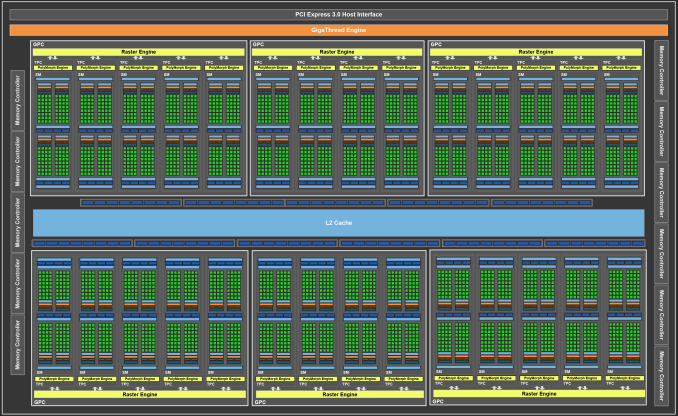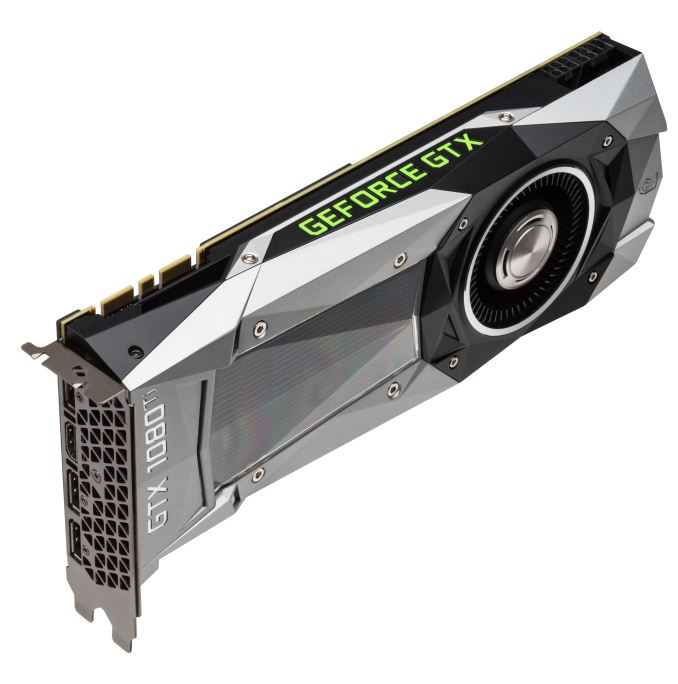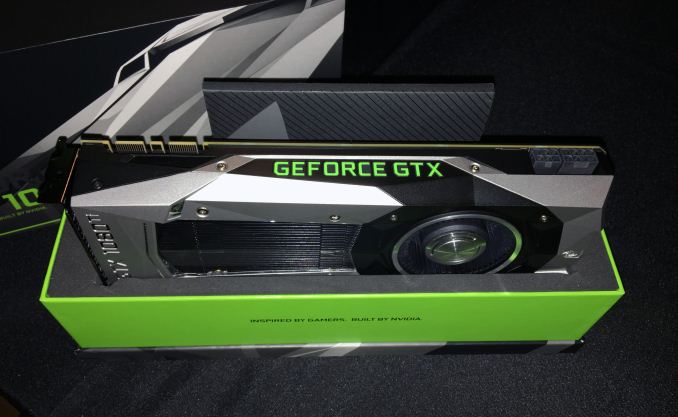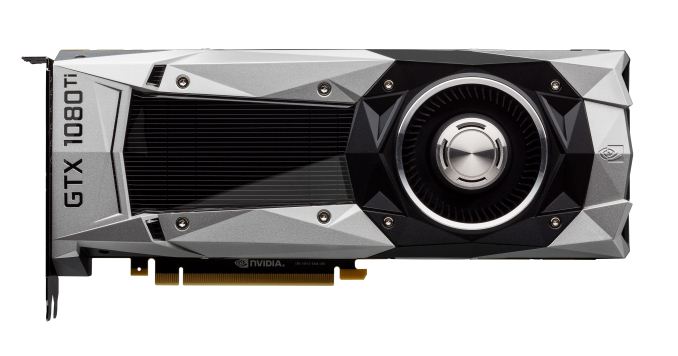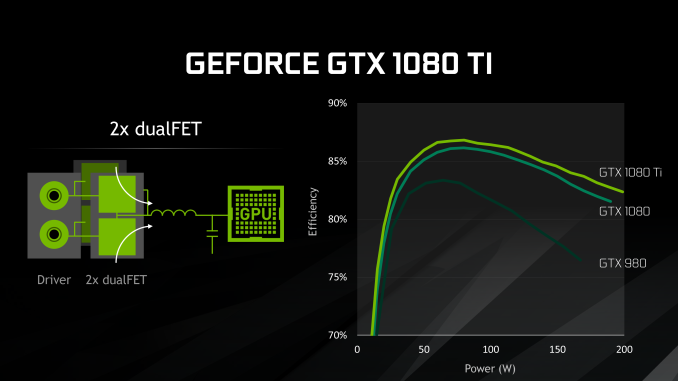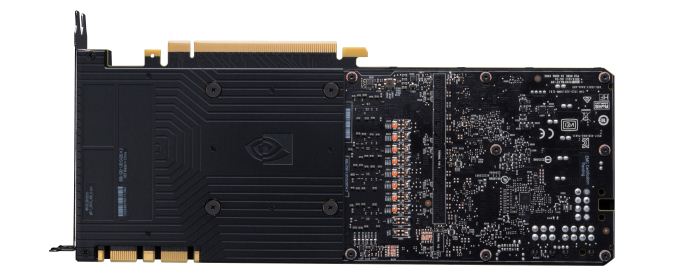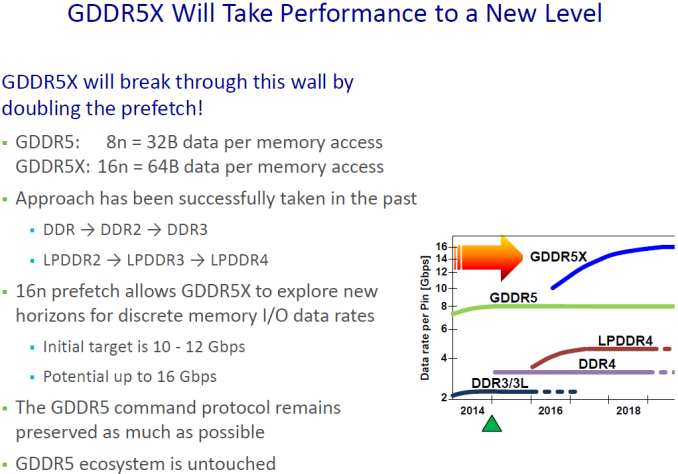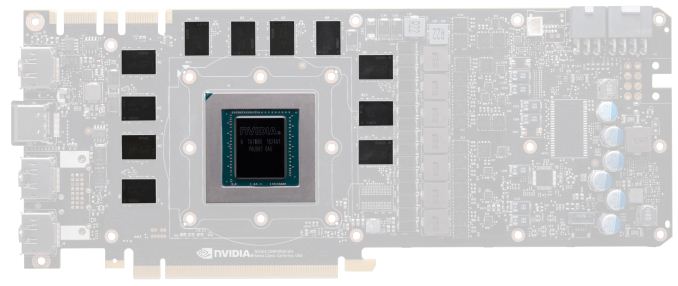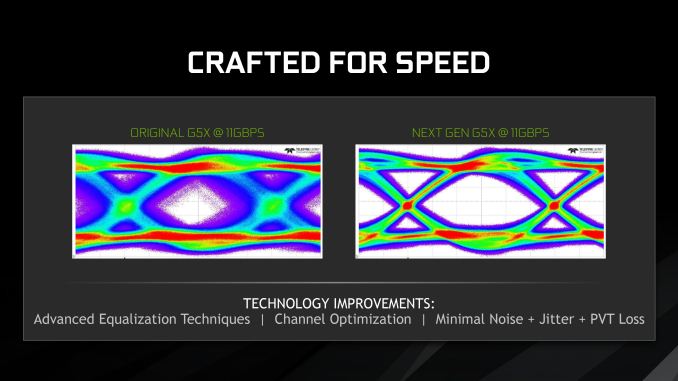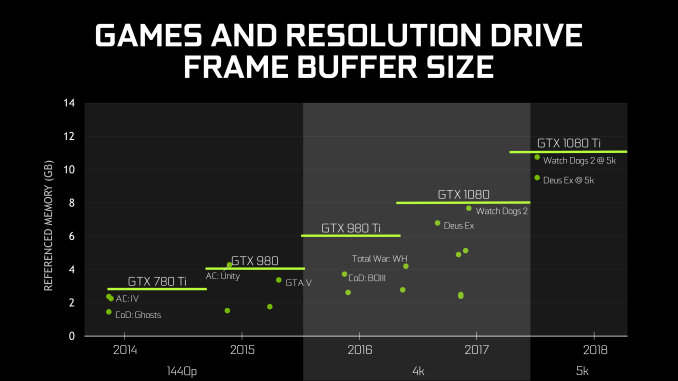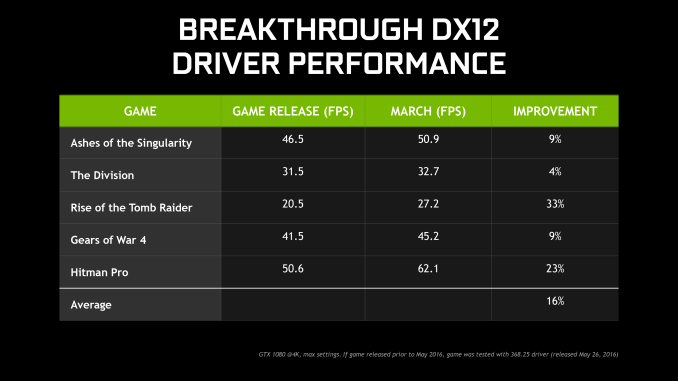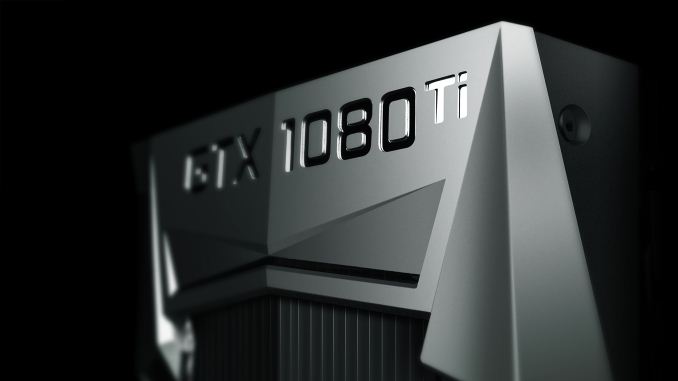
Original Link: https://www.anandtech.com/show/11180/the-nvidia-geforce-gtx-1080-ti-review
The NVIDIA GeForce GTX 1080 Ti Founder's Edition Review: Bigger Pascal for Better Performance
by Ryan Smith on March 9, 2017 9:00 AM EST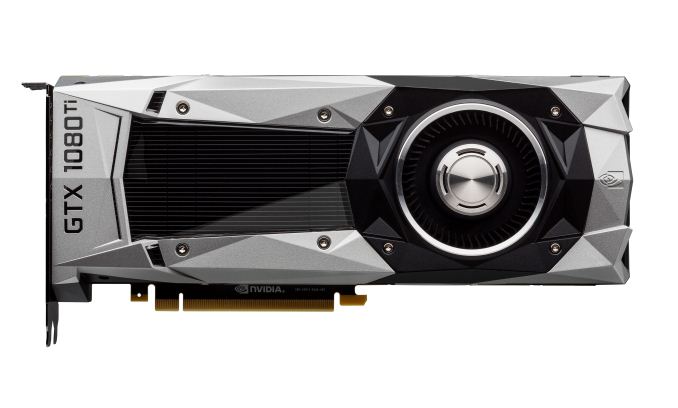
2016 will go down in history as the year where everything went NVIDIA’s way. Last year ended up being a banner year for the company, with NVIDIA’s revenue and profits growing by leaps and bounds to set some very big records. And that outcome is not a fluke; from automotive to datacenter to consumer graphics cards, the company was able to execute almost perfectly, delivering solid products built around their 16nm Pascal architecture.
But why do I bring this up in a video card review? In part because NVIDIA needs to follow up what was their greatest year ever, and in part because if it feels like NVIDIA is taking a bit of a victory lap, you wouldn’t be wrong. When NVIDIA launched the GeForce GTX 1080 back in May they set a new high bar for GPU performance, and they never once had to look back. Consequently the last 10 months have been witness to the NVIDIA’s greatest flagship-level performance lead in at least a decade; the high-end video card market and its lucrative profits have belonged to NVIDIA and NVIDIA alone.
However that was 2016. We’re now 3 months into 2017 and approaching Pascal’s first birthday, and NVIDIA needs to set the stage for the next year to come. If NVIDIA wants to repeat 2016 then they need to refresh their product lineup to deliver better performance and a better value, to capture the still-significant portion of the PC gaming market still on 28nm-generation architectures like Maxwell, Kepler, and GCN 1.x. And, as the saying goes, there’s no better place to start at than the top.
Unveiled last week at GDC and launching tomorrow is the GeForce GTX 1080 Ti. Based on NVIDIA’s GP102 GPU – aka Bigger Pascal – the job of GTX 1080 Ti is to serve as a mid-cycle refresh of the GeForce 10 series. Like the GTX 980 Ti and GTX 780 Ti before it, that means taking advantage of improved manufacturing yields and reduced costs to push out a bigger, more powerful GPU to drive this year’s flagship video card. And, for NVIDIA and their well-executed dominance of the high-end video card market, it’s a chance to run up the score even more.
| NVIDIA GPU Specification Comparison | ||||||
| GTX 1080 Ti | NVIDIA Titan X | GTX 1080 | GTX 980 Ti | |||
| CUDA Cores | 3584 | 3584 | 2560 | 2816 | ||
| Texture Units | 224 | 224 | 160 | 176 | ||
| ROPs | 88 | 96 | 64 | 96 | ||
| Core Clock | 1481MHz | 1417MHz | 1607MHz | 1000MHz | ||
| Boost Clock | 1582MHz | 1531MHz | 1733MHz | 1075MHz | ||
| TFLOPs (FMA) | 11.3 TFLOPs | 11 TFLOPs | 9 TFLOPs | 6.1 TFLOPs | ||
| Memory Clock | 11Gbps GDDR5X | 10Gbps GDDR5X | 10Gbps GDDR5X | 7Gbps GDDR5 | ||
| Memory Bus Width | 352-bit | 384-bit | 256-bit | 384-bit | ||
| VRAM | 11GB | 12GB | 8GB | 6GB | ||
| FP64 | 1/32 | 1/32 | 1/32 | 1/32 | ||
| FP16 (Native) | 1/64 | 1/64 | 1/64 | N/A | ||
| INT8 | 4:1 | 4:1 | N/A | N/A | ||
| TDP | 250W | 250W | 180W | 250W | ||
| GPU | GP102 | GP102 | GP104 | GM200 | ||
| Transistor Count | 12B | 12B | 7.2B | 8B | ||
| Die Size | 471mm2 | 471mm2 | 314mm2 | 601mm2 | ||
| Manufacturing Process | TSMC 16nm | TSMC 16nm | TSMC 16nm | TSMC 28nm | ||
| Launch Date | 03/10/2017 | 08/02/2016 | 05/27/2016 | 06/01/2015 | ||
| Launch Price | $699 | $1200 | MSRP: $599 Founders $699 |
$649 | ||
With the GTX 1080 Ti, NVIDIA is aiming for what they’re calling their greatest performance jump yet for a modern Ti product – around 35% on average. This would translate into a sizable upgrade for GeForce GTX 980 Ti owners and others for whom GTX 1080 wasn’t the card they were looking for.
We’ll start as always with the GPU at the heart of the card, GP102. With NVIDIA’s business now supporting a dedicated compute GPU – the immense GP100 – GP102 doesn’t qualify for the “Big Pascal” moniker like past iterations have. But make no mistake, GP102 is quite a bit larger than the GP104 GPU at the heart of the GTX 1080, and that translates to a lot more hardware for pushing pixels.
GTX 1080 Ti ships with 28 of GP102’s 30 SMs enabled. For those of you familiar with the not-quite-consumer NVIDIA Titan X (Pascal), this is the same configuration as that card, and in fact there are a lot of similarities between those two cards. Though for this generation the situation is not going to be cut & dry as in the past; the GTX 1080 Ti is not strictly a subset of the Titan.
The big difference on the hardware front is that NVIDIA has stripped GP102 of some of its memory/ROP/L2 capacity, which was fully enabled on the Titan. Of the 96 ROPs we get 88; the last ROP block, its memory controller, and 256KB of L2 cache have been disabled. Otherwise, relative to the current top dog on the GeForce side, GTX 1080, we’re looking at a nearly 40% increase in the number of functional units, which will put the GTX 1080 Ti in its own class.
In terms of clockspeeds the GTX 1080 Ti ships with a 1.48GHz base clock and a 1.58GHz boost clock. This is a bit lower than the clocks the GTX 1080 shipped at – 1.6GHz and 1.73GHz respectively – though par for the course for video cards based on these bigger GPUs. Though more importantly, as we’ve seen time and time again with Maxwell and Pascal, the complex nature of NVIDIA’s turbo mechanism means that the average clockspeeds of an NVIIDA card are frequently higher than NVIDIA’s official values, and that means that GTX 1080 Ti is defined more by its performance in the field than its specifications on paper.
Meanwhile on the memory front, the GTX 1080 Ti is the first card NVIDIA is equipping with partner Micron’s second-generation GDDR5X memory. This refined design allows for higher clockspeeds, allowing NVIDIA to ship the GTX 1080 Ti with an 11Gbps memory clock, a 10% increase over the 10Gbps clock found on the Titan and the GTX 1080. This memory is situated on a cut-down 352-bit memory bus – NVIDIA has disabled the last 32-bit channel in part to differentiate the card from Titan X – which works out to 11GB of memory with a total bandwidth of 484GB/sec for the GTX 1080 Ti.
Going by the numbers then, the GTX 1080 Ti offers just over 11.3 TFLOPS of FP32 performance. This puts the expected shader/texture performance of the card 28% ahead of the current GTX 1080, while the ROP throughput advantage stands 26%, and memory bandwidth at a much greater 51.2%. Real-world performance will of course be influenced by a blend of these factors, with memory bandwidth being the real wildcard. Otherwise, relative to the NVIDIA Titan X, the two cards should end up quite close, trading blows now and then.
Speaking of the Titan, on an interesting side note, NVIDIA isn’t going to be doing anything to hurt the compute performance of the GTX 1080 Ti to differentiate the card from the Titan, which has proven popular with GPU compute customers. Crucially, this means that the GTX 1080 Ti gets the same 4:1 INT8 performance ratio of the Titan, which is critical to the cards’ high neural networking inference performance. As a result the GTX 1080 Ti actually has slightly greater compute performance (on paper) than the Titan. And NVIDIA has been surprisingly candid in admitting that unless compute customers need the last 1GB of VRAM offered by the Titan, they’re likely going to buy the GTX 1080 Ti instead.
Moving on, the card’s 250W TDP should not come as a surprise. This has been NVIDIA’s segment TDP of choice for Titan and Ti cards for a while now, and the GTX 1080 Ti isn’t deviating from that. GTX 1080 Ti isn’t necessarily meant to be more efficient than GTX 1080 – we’re still looking at the same architecture on the same manufacturing node – but instead it’s a more powerful GeForce for those users who are willing to trade power consumption for improved performance.
With the specs out of the way, let’s talk about market positioning, pricing, and availability. Like the GTX 1080 before it, NVIDIA is once again going to be working with partners to offer a mix of reference and custom designs. The GTX 1080 Ti will initially be offered in a Founder’s Edition design, while partners are also bringing up their own semi and fully custom designs to be released in April. Importantly however, unlike the GTX 1080 & GTX 1070, NVIDIA has done away with the Founder’s Edition premium for the GTX 1080 Ti. The MSRP of the card will be the MSRP for both the Founder’s Edition and partners’ custom cards. This makes pricing more consistent, though I’m curious to see how this plays out with partners, as they benefitted from the premium in the form of more attractive pricing for their own cards.
As for pricing, with the launch of the GeForce GTX 1080 Ti, NVIDIA and their partners are shuffling their product stacks to accommodate the new card. The GTX 1080 Ti is being priced at $699, which was the original launch price for the GeForce GTX 1080 Founder’s Edition. The GTX 1080 has in turn received a price cut, with the base cards going down to $499, and the Founder’s Edition going down to $549. For better or worse this $699 price tag does work out to being a bit of a price hike over the GeForce GTX 980 Ti – it launched at $649 two years ago – but at the same time it's still more aggressive than I had been expecting given the GTX 1080's launch price last year.
The GTX 1080 Ti will be launching tomorrow, with today’s review embargo designed to whet your appetite (and perhaps open up your wallet). NVIDIA and their partners will be selling the Founder’s Edition cards for the launch, so while it’s likely that the first shipment will sell out, everyone should have their usual choice of tier 1 retailers. Meanwhile in a bit of news that didn’t get disclosed at GDC, NVIDIA is including the GTX 1080 Ti in their latest Prepare for Battle game bundle, an unexpected move given that NVIDIA has shied away from launch bundles on high-end cards in recent years. Under NVIDIA’s latest bundle program, buyers will qualify for a free copy of either Ubisoft’s For Honor or Tom Clancy’s Ghost Recon Wildlands, both of which have launched in the last few weeks.
Finally, looking at the competitive landscape, there’s not much to say right now. GTX 1080 Ti is NVIDIA’s chance to run up the score even further, giving them a solid 1-2-3 position in the market. GTX 1080 Ti will eventually have to do battle with AMD’s RX Vega video cards sometime in the next quarter, but as that’s still months off and Vega is an unknown in terms of performance, it’s not a factor at this time. For GTX 980 Ti and GTX 780 Ti owners, this is the card NVIDIA would like to sell you as your next upgrade. And if you managed to hold off on buying a GTX 1080 FE last year, then the GTX 1080 Ti is going to bring a lot more performance for the same price.
| Spring 2017 GPU Pricing Comparison | |||||
| AMD | Price | NVIDIA | |||
| $699 | GeForce GTX 1080 Ti | ||||
| $499 | GeForce GTX 1080 | ||||
| $399 | GeForce GTX 1070 | ||||
| $249 | GeForce GTX 1060 (6GB) | ||||
| Radeon RX 480 (8GB) | $209 | ||||
Meet the GeForce GTX 1080 Ti Founder’s Edition
When it comes to the design of the GeForce GTX 1080 Ti Founder’s Edition, if you’ve seen a high-end NVIDIA card in the last 4 years then you know roughly what to expect. NVIDIA has found their sweet spot in card design, and while the GTX 1080 Ti does have a few wrinkles of its own, it’s not a radical departure from the likes of the GTX 1080, GTX 980 Ti, or GTX 780 Ti. GeForce GTX 1080 Ti is a traditional NVIDIA reference card, with all the competence, performance, and functionality that entails.
At a high level, the GTX 1080 Ti Founder’s Edition is a 10.5-inch long blower-type card comprised of a cast aluminum housing and held together using a combination of rivets and screws. Designed as much for aesthetics as functionality, NVIDIA’s use of well-secured metal has done a good job of tempering noise generation, and for those who like to show off their rigs, the basic design and LED-backlit logo are unmistakable.
Cracking open the card and removing the shroud exposes the card’s fan and heatsink assembly. Once again NVIDIA is lining the entire card with an aluminum baseplate, which provides heatsinking capabilities for the VRMs and other discrete components below it, along with providing additional protection for the board. Like past NVIDIA 250W cards, the GTX 1080 FE uses NVIDIA’s vapor chamber cooler in order to maximize the heat transfer between the GPU/VRMs/DRAM and the aluminum heatsink above. As far as blower-type cards go, it’s still the card to beat.
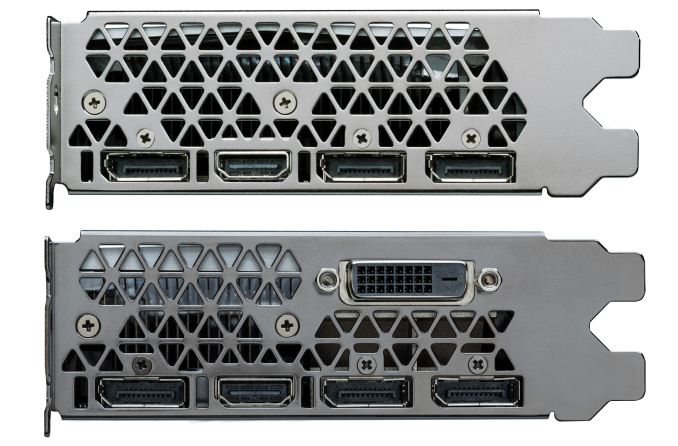
Airflow: GTX 1080 Ti vs. GTX 1080
For the GTX 1080 Ti, NVIDIA has refined this basic design just a bit in order to further increase airflow. The key change here is that NVIDIA has removed the DVI port that in past designs took up part of the second slot used for ventilation. Consequently the entire slot is now open for airflow. As we’ll see in our benchmarks the practical difference in noise is not very much, but it still means the GTX 1080 Ti is quieter than the GTX 980 Ti and GTX 780 Ti that came before it.
Otherwise in a blink-and-you’ll-miss-it kind of change, NVIDIA has also tweaked the tapering of the shroud itself to maximize the airflow. It’s difficult to pick up in pictures, but the shroud is just a bit thinner and the bottom of the shroud is just a bit higher, allowing just a bit more unobstructed airflow through the card. This subtle change is a good example of where NVIDIA is in their card design cycle: with the major performance elements of the cooler design essentially being a solved problem, NVIDIA is now toying with small changes to eke out just a bit more performance.
Popping off the cooler, we see NVIDIA’s reference PCB. This appears to be the same PCB used on the similarly configured GP102-based Titan X Pascal, and is consistent with NVIDIA’s past reuse of PCBs.
Of particular note, we can see that NVIDIA has equipped the card with a surprising number of MOSFETs, and it turns out there’s a good reason for this. For the GTX 1080 Ti, NVIDIA has opted to go with two dualFETs for each of the GPU’s 7 power phases, as opposed to the traditional 1-per-phase design used in most NVIDIA cards. While this drives up the total cost of the card a bit, the payoff is that it improves on the card’s power delivery efficiency a bit, especially at the 200W+ range the GTX 1080 Ti operates in.
This isn’t the first overall GeForce card we’ve seen with a large number of MOSFETs – NVIDIA’s board partners at times treat it as a contest in and of itself – but this is the first time we’ve seen NVIDIA use such a large number and promote it. Generally speaking additional phases and MOSFETs can improve a power delivery subsystem by spreading out the load – and in a game of inches, every bit counts – but the additional MOSFETs are subject to diminishing returns both at idle and load.
Otherwise this is a fairly typical NVIDIA PCB. The reuse of the Titan PCB means that the board should work with water blocks and other add-ons designed for the Titan, though I suspect for best overclocking results the hardcore overclockers will continue to want to look to more specialized designs from the likes of MSI, EVGA, Asus, and others.
Flipping the card over to the back, we find NVIDIA’s now-standard segmented backplate. The presence of the backplate helps to protect the card, but one or both segments can be removed to add precious millimeters of room for airflow in tightly packed SLI designs.
Moving on, towards the top of the card we find the requisite SLI and power connectors. Like NVIDIA’s 250W cards before it, the GTX 1080 Ti features a 6 pin + 8 pin setup. NVIDIA’s 250W limit means that, on-board circuitry aside, the power delivery system isn’t anywhere close to its 300W limit. Otherwise we find a pair of SLI connectors, which like the rest of the GTX 10-series cards are designed for use with NVIDIA’s latest-generation High Bandwidth (HB) bridges.
Finally, getting back to NVIDIA’s display I/O configuration, as we mentioned earlier NVIDIA has removed the DVI port from the card in favor of giving the card unobstructed airflow for better cooling. As a result, the card features only modern ports: 3x DisplayPort 1.4 and 1x HDMI 2.0b. With that said, as a consolation item of sorts for the remaining DVI users, NVIDIA is including a DisplayPort-to-SL-DVI adapter with the Founder’s Edition card. This doesn’t perfectly replace the missing DVI port – in particular, it can’t drive 2560x1440 or 2560x1600 displays – but for lower resolution displays it will do the trick. But if it’s not already clear from this change and the number of motherboards to drop DVI over the years, DVI’s days are numbered, and we’re only going to continue to see DVI ports go away at this point.
Second Generation GDDR5X: More Memory Bandwidth
One of the more unusual aspects of the Pascal architecture is the number of different memory technologies NVIDIA can support. At the datacenter level, NVIDIA has a full HBM 2 memory controller, which they use for the GP100 GPU. Meanwhile for consumer and workstation cards, NVIDIA equips GP102/104 with a more traditional memory controller that supports both GDDR5 and its more exotic cousin: GDDR5X.
A half-generation upgrade of sorts, GDDR5X was developed by Micron to further improve memory bandwidth over GDDR5. GDDR5X further increases the amount of memory bandwidth available from GDDR5 through a combination of a faster memory bus coupled with wider memory operations to read and write more data from DRAM per clock. And though it’s not without its own costs such as designing new memory controllers and boards that can accommodate the tighter requirements of the GDDR5X memory bus, GDDR5X offers a step in performance between the relatively cheap and slow GDDR5, and relatively fast and expensive HBM2.
With rival AMD opting to focus on HBM2 and GDDR5 for Vega and Polaris respectively, NVIDIA has ended up being the only PC GPU vendor to adopt GDDR5X. The payoff for NVIDIA, besides the immediate benefits of GDDR5X, is that they can ship with memory configurations that AMD cannot. Meanwhile for Micron, NVIDIA is a very reliable and consistent customer for their GDDR5X chips.
When Micron initially announced GDDR5X, they laid out a plan to start at 10Gbps and ramp to 12Gbps (and beyond). Now just under a year after the launch of the GTX 1080 and the first generation of GDDR5X memory, Micron is back with their second generation of memory, which of course is being used to feed the GTX 1080 Ti. And NVIDIA, for their part, is very eager to talk about what this means for them.
With Micron’s second generation GDDR5X, NVIDIA is now able to equip their cards with 11Gbps memory. This is a 10% year-over-year improvement, and a not-insignificant change given that memory speeds increase at a fraction of GPU throughput. Coupled with GP102’s wider memory bus – which sees 11 of 12 lanes enabled for the GTX 1080 Ti – and NVIDIA is able to offer just over 480GB/sec of memory bandwidth with this card, a 50% improvement over the GTX 1080.
For NVIDIA, this is something they’ve been eagerly awaiting. Pascal’s memory controller was designed for higher GDDR5X memory speeds from the start, but the memory itself needed to catch up. As one NVIDIA engineer put it to me “We [NVIDIA] have it easy, we only have to design the memory controller. It’s Micron that has it hard, they have to actually make memory that can run at those speeds!”
Micron for their part has continued to work on GDDR5X after its launch, and even with what I’ve been hearing was a more challenging than anticipated launch last year, both Micron and NVIDIA seem to be very happy with what Micron has been able to accomplish with their second generation GDDR5X memory.
As demonstrated in eye diagrams provided by NVIDIA, Micron’s second generation memory coupled with NVIDIA’s memory controller is producing a very clean eye at 11Gbps, whereas the first generation memory (which was admittedly never speced for 11Gbps) would produce a very noisy eye. Consequently NVIDIA and their partners can finally push past 10Gbps for the GTX 1080 Ti and the forthcoming factory overclocked GTX 1080 and GTX 1060 cards.
Under the hood, the big developments here were largely on Micron’s side. The company continued to optimize their metal layers for GDDR5X, and combined with improved test coverage were able to make a lot of progress over the first generation of memory. This in turn is coupled with improvements in equalization and noise reduction, resulting in the clean eye we see above.
Longer-term here, GDDR6 is on the horizon. But before then, Micron is still working on further improvements to GDDR5X. Micron’s original goal was to hit 12Gbps with this memory technology, and while they’re not there quite yet, I wouldn’t be too surprised to be having this conversation once again for 12Gbps memory within the next year.
Finally, speaking of memory, it’s worth noting that NVIDIA also dedicated a portion of their GTX 1080 Ti presentation to discussing memory capacity. To be honest, I get the impression that NVIDIA feels like they need to rationalize equipping the GTX 1080 Ti with 11GB of memory, beyond the obvious conclusions that it is cheaper than equipping the card with 12GB and it better differentiates the GTX 1080 Ti from the Titan X Pascal.
In any case, NVIDIA believes that based on historical trends, 11GB will be sufficient for 5K gaming in 2018 and possibly beyond. Traditionally NVIDIA has not been especially generous on memory – cards like the 3GB GTX 780 Ti and 2GB GTX 770 felt the pinch a bit early – so going with a less-than-full memory bus doesn’t improve things there. On the other hand with the prevalence of multiplatform games these days, one of the biggest drivers in memory consumption was that the consoles had 8GB of RAM each; and with 11GB, the GTX 1080 Ti is well ahead of the consoles in this regard.
Driver Performance & The Test
Alongside the launch of the GTX 1080 Ti, NVIDIA is also touting the performance of their drivers. For most users who have been regularly updating their drivers to begin with, I don’t think there’s anything too surprising here. But because of NVIDIA’s talk of driver performance gains, I’ve already seen some confusion here over whether the GTX 1080 Ti launch driver (378.78) is a special performance driver or not. For the record, it is not.
In their presentation, NVIDIA outlined their driver performance gains in DX12 since the launch of various DX12 games, including Ashes of the Singularity, Hitman, and Rise of the Tomb Raider. All of these games have seen performance improvements, but what’s critical here is that this is over the long-run, since the launch of the GTX 1080 and these respective games.
The 378.78 driver in that respect is nothing special. In terms of driver release, NVIDIA is already a few releases into the R378 branch, so any big code changes for this branch have already been released to the public in earlier driver builds.
In any case, for reference purposes, here’s how performance of the GTX 1080 stacks up now compared to performance at launch.
| GeForce GTX Driver Performance Gains: July 2016 vs. March 2017 (4K) | |||
| Game | GTX 1080 | GTX 980 Ti | |
| Rise of the Tomb Raider |
Even
|
Even
|
|
| DiRT Rally |
+8%
|
+7%
|
|
| Ashes of the Singularity |
+11%
|
+14%
|
|
| Battlefield 4 |
Even
|
Even
|
|
| Crysis 3 |
Even
|
Even
|
|
| The Witcher 3 |
|
Even
|
|
| The Division* |
-7%
|
-9%
|
|
| Grand Theft Auto V |
+2%
|
Even
|
|
| Hitman (DX12) |
+26%
|
+24%
|
|
As was the case with NVIDIA’s data, the performance gains vary from game to game. Some games have not budged, whereas others like Hitman have improved significantly, and outlier The Division has actually regressed a bit due to some major updates that have happened to the game in the same time period. But at the end of the day, these are performance gains that have accumulated over the months and are already available in the latest drivers from NVIDIA.
The Test
For our review of the GTX 1080 Ti, we’re using NVIDIA’s 378.78 driver.
| CPU: | Intel Core i7-4960X @ 4.2GHz |
| Motherboard: | ASRock Fatal1ty X79 Professional |
| Power Supply: | Corsair AX1200i |
| Hard Disk: | Samsung SSD 840 EVO (750GB) |
| Memory: | G.Skill RipjawZ DDR3-1866 4 x 8GB (9-10-9-26) |
| Case: | NZXT Phantom 630 Windowed Edition |
| Monitor: | Asus PQ321 |
| Video Cards: | NVIDIA GeForce GTX 1080 Ti Founders Edition NVIDIA GeForce GTX 1080 Founders Edition NVIDIA GeForce GTX 980 Ti NVIDIA GeForce GTX 780 Ti AMD Radeon Fury X |
| Video Drivers: | NVIDIA Release 378.78 AMD Radeon Software Crimson 17.3.1 |
| OS: | Windows 10 Pro |
Rise of the Tomb Raider
Starting things off in our benchmark suite is the built-in benchmark for Rise of the Tomb Raider, the latest iteration in the long-running action-adventure gaming series. One of the unique aspects of this benchmark is that it’s actually the average of 4 sub-benchmarks that fly through different environments, which keeps the benchmark from being too weighted towards a GPU’s performance characteristics under any one scene.
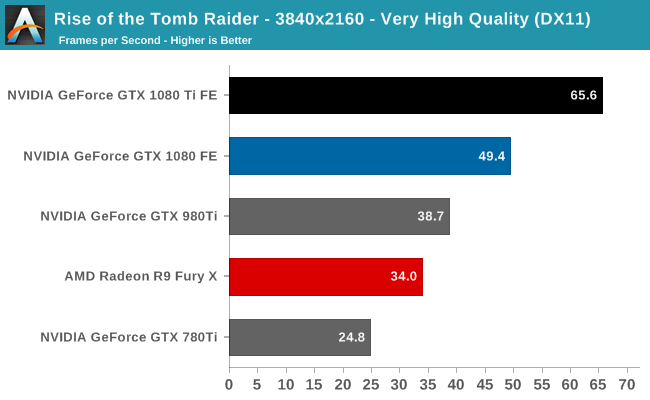
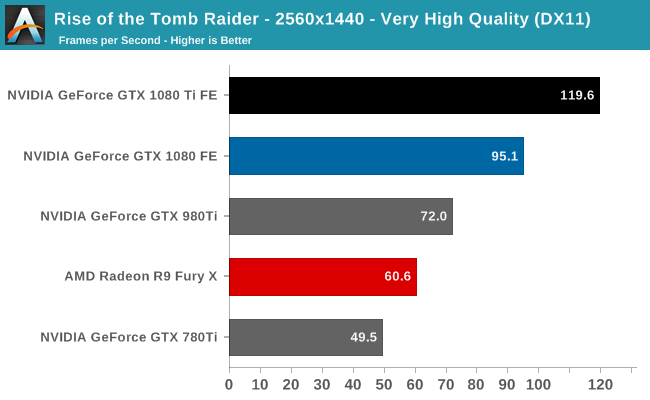
As we’re looking at the highest of high-end cards here, the performance comparisons are pretty straightforward. There’s the GTX 1080 Ti versus the GTX 1080, and then for owners with older cards looking for an upgrade, there’s the GTX 1080 Ti versus the GTX 980 Ti and GTX 780 Ti. It goes without saying that the GTX 1080 Ti is the fastest card that is (or tomorrow will be) on the market, so the only outstanding question is just how much faster NVIDIA’s latest card really is.
As you’d expect, the GTX 1080 Ti’s performance lead is dependent in part on the resolution tested. The higher the resolution the more GPU-bound a game is, and the more opportunity there is for the card to stretch its 3GB advantage in VRAM. In the case of Tomb Raider, the GTX 1080 Ti ends up being 33% faster than the GTX 1080 at 4K, and 26% faster at 1440p.
Otherwise against the 28nm GTX 980 Ti and GTX 780 Ti, the performance gains become very large very quickly. The GTX 1080 Ti holds a 70% lead over the GTX 980 here at 4K, and it’s a full 2.6x faster than the GTX 780 Ti. The end result is that whereas the GTX 980 Ti was the first card to crack 30fps at 4K on Tomb Raider, the GTX 1080 Ti is the first card that can actually average 60fps or better.
DiRT Rally
For the racing game in our benchmark suite we have Codemasters’ DiRT Rally. Codemasters continues to set the bar for graphical fidelity in racing games, delivering realistic looking environments with layered with additional graphical effects. Based on their in-house EGO engine, DiRT Rally includes a number of DirectCompute based compute shader effects, and while it’s not the most punishing game in our suite, it still takes a very good card to sustain the 60fps frame rate that driving games are best played at.
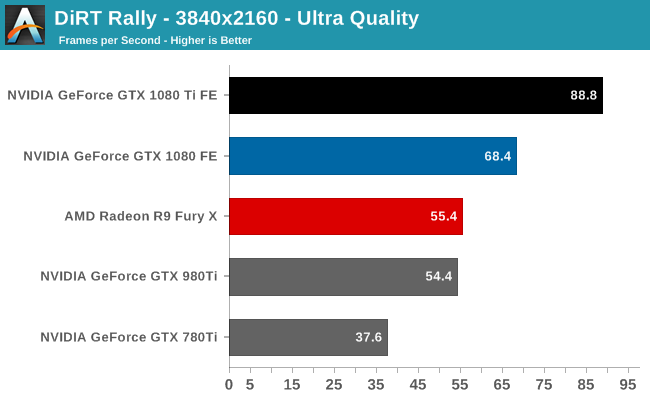
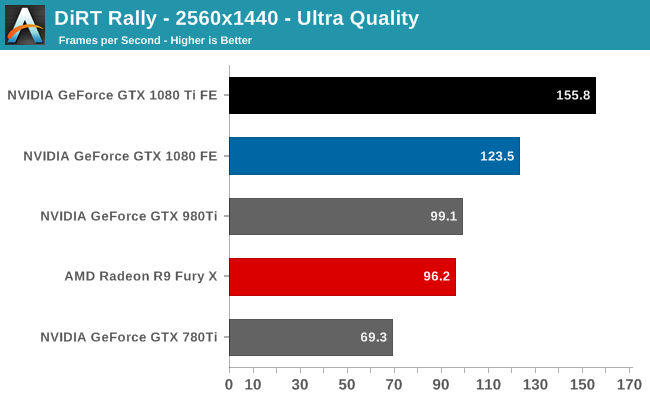
With DiRT Rally, the GTX 1080 was already capable of breaking 60fps at 4K, so the GTX 1080 Ti just adds to the lead here. Though it’s not for naught; with high refresh rate 4K monitors due a bit later this year, the GTX 1080 Ti will be a good match. Otherwise for high refresh rate 1440p monitors, the GTX 1080 Ti is the first card that should be able to peg those monitors at their full 144Hz refresh rate.
Ashes of the Singularity
Sorely missing from our benchmark suite for quite some time have been RTSes, which don’t enjoy quite the popularity they once did. As a result Ashes holds a special place in our hearts, and that’s before we talk about the technical aspects. Based on developer Oxide Games’ Nitrous Engine, Ashes has been designed from the ground up for low-level APIs like DirectX 12. As a result of all of the games in our benchmark suite, this is the game making the best use of DirectX 12’s various features, from asynchronous compute to multi-threadeded work submission and high batch counts. What we see can’t be extrapolated to all DirectX 12 games, but it gives us a very interesting look at what we might expect in the future.
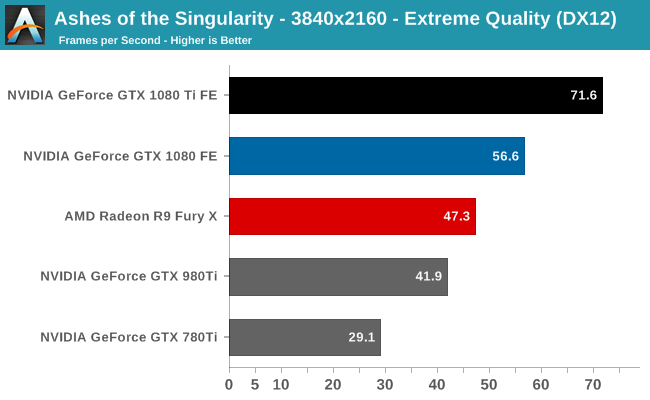
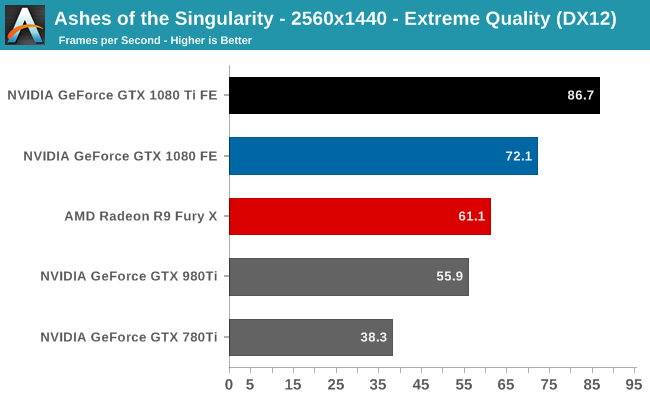
Of all of the games in our benchmark suite, Ashes is perhaps the most unusual. Besides being built for low-level APIs like DirectX 12 from the start, its rendering optimizations scale very well with resolution. As a result it takes a lot of rendering power to play Ashes with all the bells & whistles turned on, but once you can reach that point, going to 4K isn’t too much harder.
In any case, the GTX 1080 Ti becomes the first card to crack 60fps at 4K in this game. In doing so it’s 27% faster than the GTX 1080, and 71% faster than the GTX 980 Ti. Performance has actually reached a point that if we drop to 1440p, we start being CPU-limited a not-insignificant percentage of the time. So the GTX 1080 Ti outright needs 4K to really put its best foot forward.
Battlefield 4
One of the older games in our benchmark suite, DICE’s Battlefield 4 remains a staple of MP gaming. Even at its age, Battlefield 4 remained a challenging game in its own right, as very few mass market MP shooters push the envelope on graphics quality right now. As these benchmarks are from single player mode, based on our experiences our rule of thumb here is that multiplayer framerates will dip to half our single player framerates, which means a card needs to be able to average at least 60fps if it’s to be able to hold up in multiplayer.
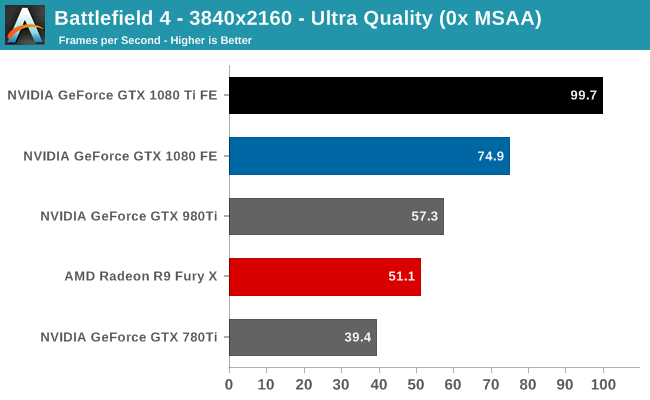
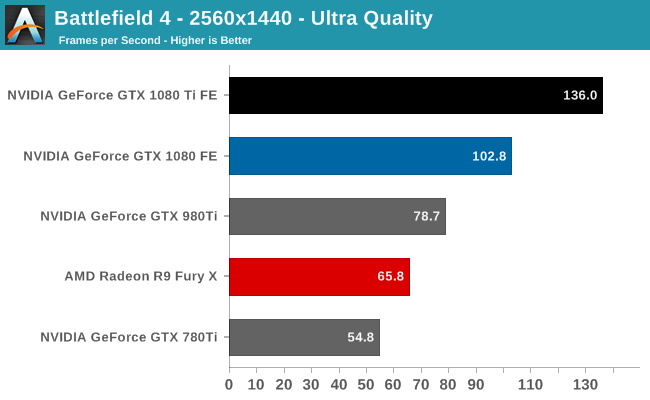
When we designed this test suite last year, we opted to go without MSAA at 4K given its very high cost on the Frostbite engine. However with the GTX 1080 Ti, the card is fast enough that it is still going to hit smooth 60fps framerates even with MSAA. With a 33% performance lead over the GTX 1080 and a 74% performance lead over the GTX 980 Ti, you can in fact finally have it all with Battlefield 4, even at 4K.
Crysis 3
Still one of our most punishing benchmarks 3 years later, Crysis 3 needs no introduction. Crytek’s DX11 masterpiece, Crysis 3’s Very High settings still punish even the best of video cards, never mind the rest. Along with its high performance requirements, Crysis 3 is a rather balanced game in terms of power consumption and vendor optimizations. As a result it can give us a good look at how our video cards stack up on average, and later on in this article how power consumption plays out.
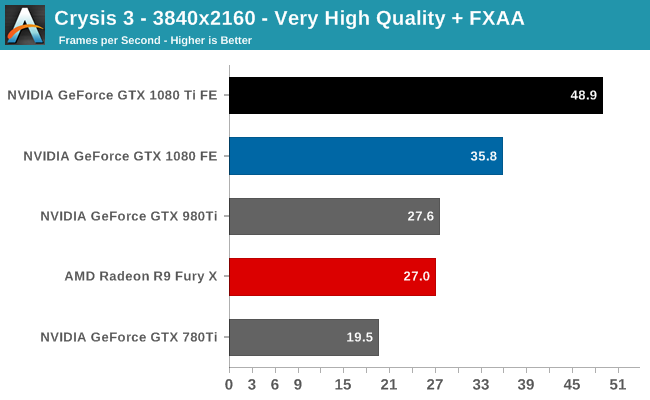
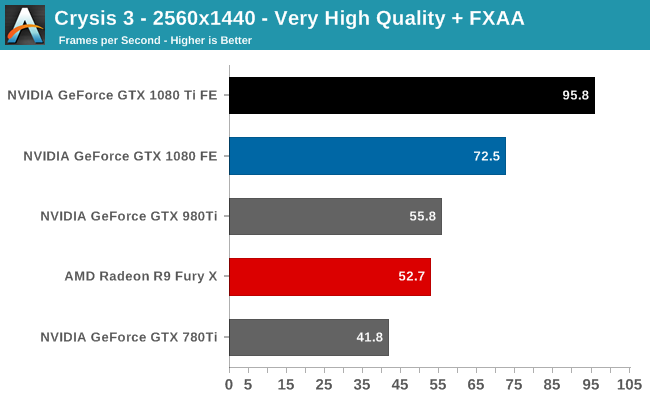
Crysis 3 will vex cards at 4K for at least one more generation. At 48.9fps, the GTX 1080 Ti is the fastest of the bunch, and is starting to approach the 60fps mark. Still, even with a 36% performance lead over the GTX 1080 and a 77% performance lead over the GTX 980 Ti, 60fps is a bit more than any one card can handle.
The Witcher 3
The third game in CD Projekt RED’s expansive RPG series, The Witcher 3 is our RPG benchmark of choice. Utilizing the company’s in-house engine, REDengine 3, The Witcher makes use of an array of DirectX 11 features, all of which combine to make the game both stunning and surprisingly GPU-intensive. Our benchmark is based on an action-heavy in-engine cutscene early in the game, and Hairworks is disabled.
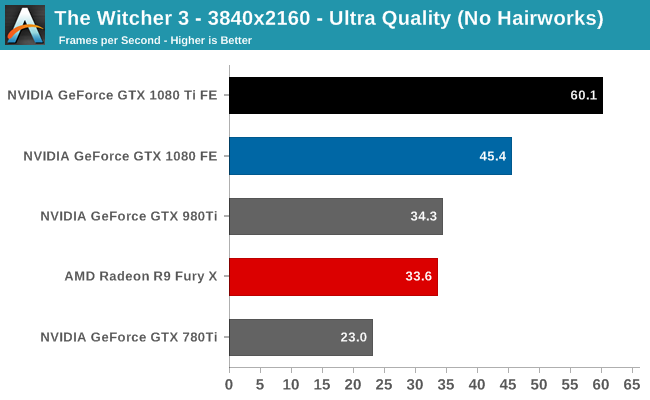
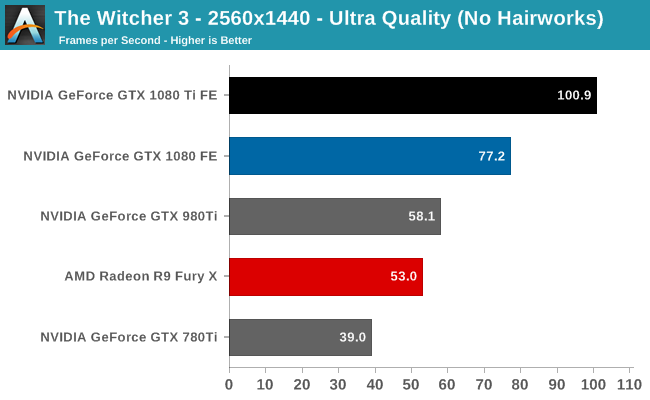
NVIDIA primarily promotes the GTX 1080 Ti as a 4K card, and for good reason. Thanks to Bigger Pascal, NVIDIA finally has the performance to break 60fps on a number of games at 4K, with The Witcher 3 chief among them. At 60.1fps it just makes that mark, with virtually no room to spare.
Overall this game is a strong showing for NVIDIA’s newest card. The GTX 1080 Ti picks up another 32% over the GTX 1080, and 75% over the last-generation GTX 980 Ti.
The Division
The final first person shooter in our benchmark suite, The Division is a multiplayer-only game powered by Ubisoft’s Snowdrop engine. The game’s design focuses on detailed urban environments and utilizes dynamic global illumination for parts of its lighting. For our testing we use the game’s built-in benchmark, which cycles through a number of scenes/areas of the game.
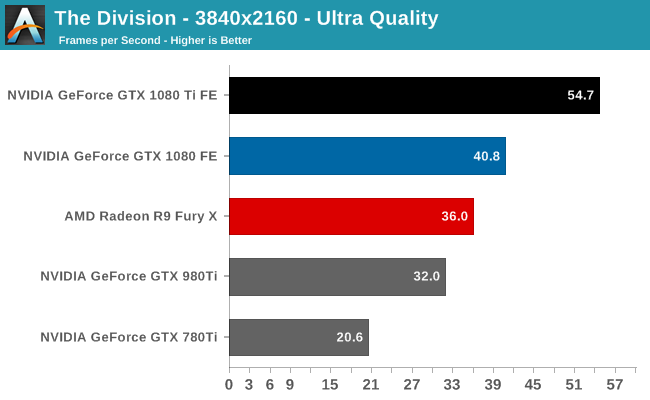
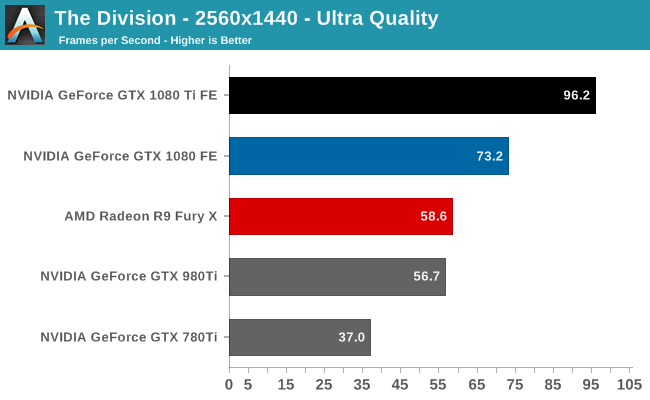
Unlike The Witcher, NVIDIA won’t be able to hit 60fps with the GTX 1080 Ti at 4K, but at 54.7fps, they come close. Otherwise at 1440p, there’s performance to spare, which should make high refresh rate monitor owners happy.
On a relative basis, this is another strong game for the GTX 1080 Ti. The card picks up 34% over the GTX 1080, and 71% over the GTX 980 Ti. And for those GTX 780 Ti owners still out there, we’re looking at a pretty consistent 2.6x increase in performance across all resolutions.
Grand Theft Auto V
The latest edition of Rockstar’s venerable series of open world action games, Grand Theft Auto V was originally released to the last-gen consoles back in 2013. However thanks to a rather significant facelift for the current-gen consoles and PCs, along with the ability to greatly turn up rendering distances and add other features like MSAA and more realistic shadows, the end result is a game that is still among the most stressful of our benchmarks when all of its features are turned up. Furthermore, in a move rather uncharacteristic of most open world action games, Grand Theft Auto also includes a very comprehensive benchmark mode, giving us a great chance to look into the performance of an open world action game.
On a quick note about settings, as Grand Theft Auto V doesn't have pre-defined settings tiers, I want to quickly note what settings we're using. For "Very High" quality we have all of the primary graphics settings turned up to their highest setting, with the exception of grass, which is at its own very high setting. Meanwhile 4x MSAA is enabled for direct views and reflections. This setting also involves turning on some of the advanced redering features - the game's long shadows, high resolution shadows, and high definition flight streaming - but it not increasing the view distance any further.
Otherwise for "High" quality we take the same basic settings but turn off all MSAA, which significantly reduces the GPU rendering and VRAM requirements.
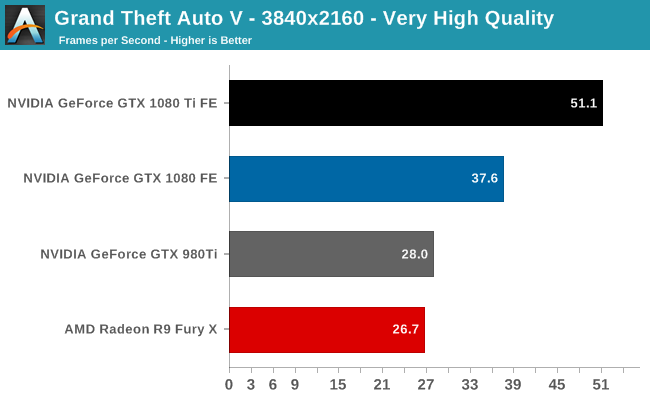
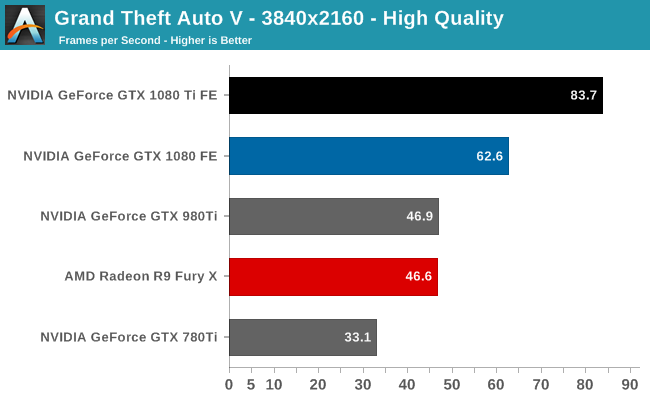
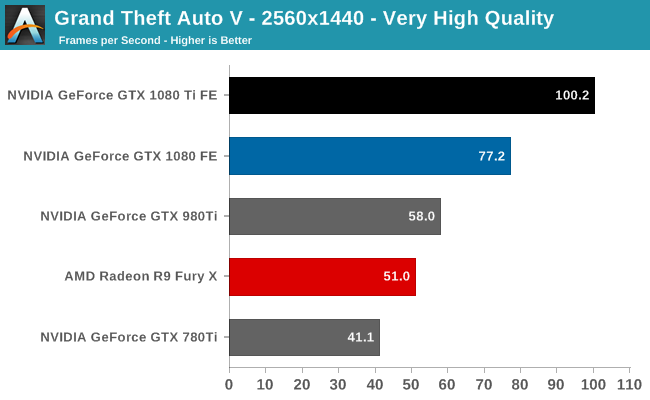
Grand Theft Auto V is another game where the GTX 1080 Ti won’t quite reach 60fps at 4K with all the bells & whistles, but it gets close in doing so. Given that this was originally a console game that ran at 30fps, 51.1 should make a lot of people reasonably satisfied, but there’s always room for improvement.
Relative to the GTX 980 Ti, this is actually the GTX 1080 Ti’s best game; it picks up a better-than-average 83% in performance. I suspect that GTAV is an outlier that is especially memory bandwidth sensitive, benefitting from the combination of a raw 44% increase in memory bandwidth from the previous generation, and NVIDIA’s improved memory compression technology on the Pascal architecture.
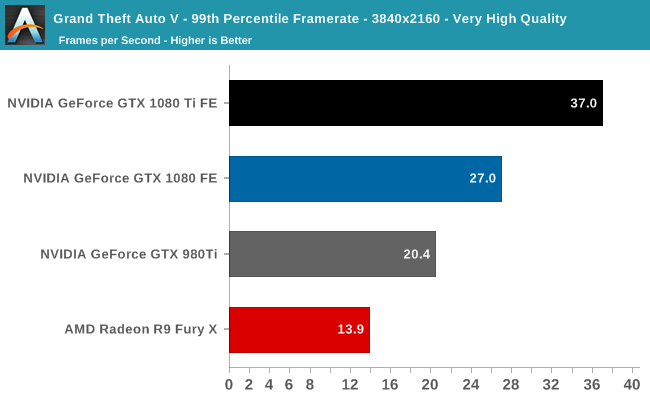
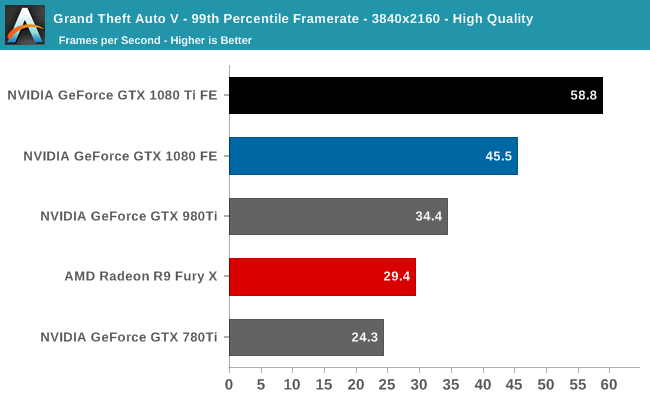
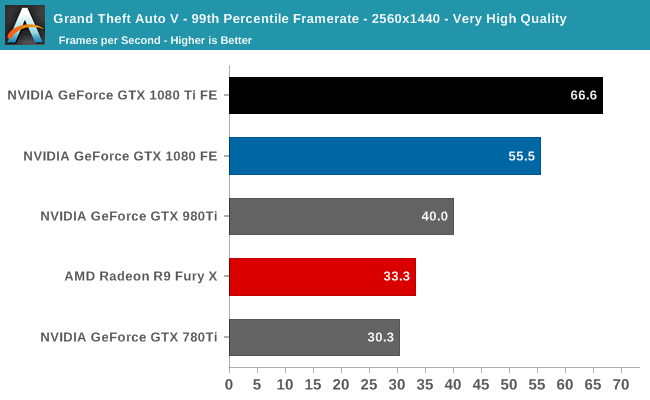
Looking at the minimum framerates, the story is much the same. For gamers looking for high minimum framerates, the GTX 1080 Ti is the first card that can deliver better than 30fps at the 99th percentile. So while it can’t average 60fps, it also will never drop to the 30fps rate that its console counterparts are capped at in the first place.
Hitman
The final game in our 2016 benchmark suite is the 2016 edition of Hitman, the latest title in the stealth-action franchise. The game offers two rendering paths: DirectX 11 and DirectX 12, with the latter being the case of DirectX 12 being added after the fact. As with past Hitman games, the latest proves to have a good mix of scenery and high model counts to stress modern video cards.
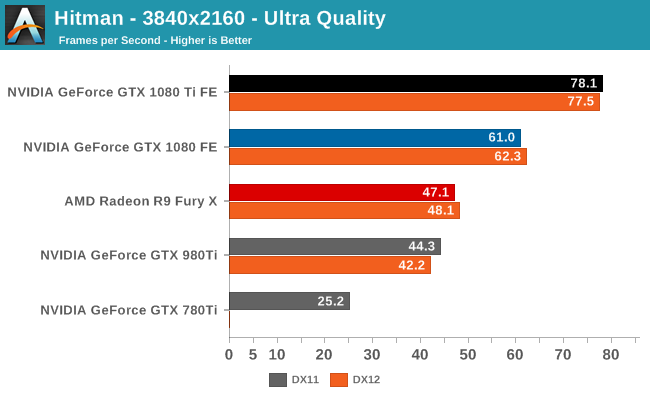
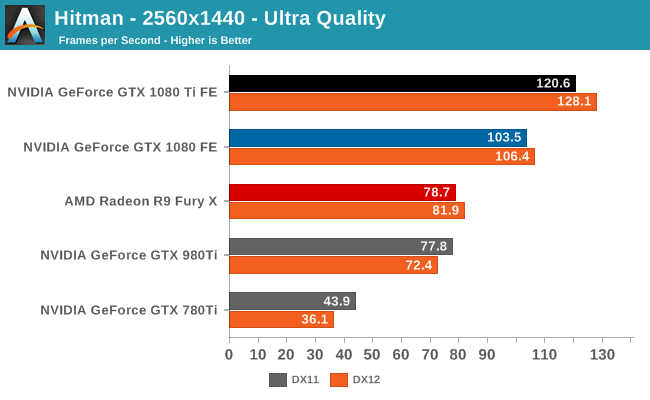
Wrapping things up on the gaming side, we have Hitman. While several DX11 games have added DX12 over the last year, Hitman is perhaps the most interesting case both for driver optimization purposes, and just what the developers have been able to wring out. For the latest generation of cards, the game’s DX12 performance is more or less a wash; it’s not consistently better than DX11 in GPU-bound scenarios. However once we get CPU-bound, the threading and CPU overhead improvements of DX12 make themselves felt, improving performance on even the all-powerful GTX 1080 Ti at 1440p.
By the numbers then, under DX12 the GTX 1080 Ti picks up 24% over the GTX 1080, which is actually a smaller than average gain. Against the GTX 980 Ti however, NVIDIA’s latest card leads by 83%, making for a very strong generational improvement.
Compute
Shifting gears, let’s take a look at compute performance on GTX 1080 Ti.
Starting us off for our look at compute is LuxMark3.1, the latest version of the official benchmark of LuxRender. LuxRender’s GPU-accelerated rendering mode is an OpenCL based ray tracer that forms a part of the larger LuxRender suite. Ray tracing has become a stronghold for GPUs in recent years as ray tracing maps well to GPU pipelines, allowing artists to render scenes much more quickly than with CPUs alone.
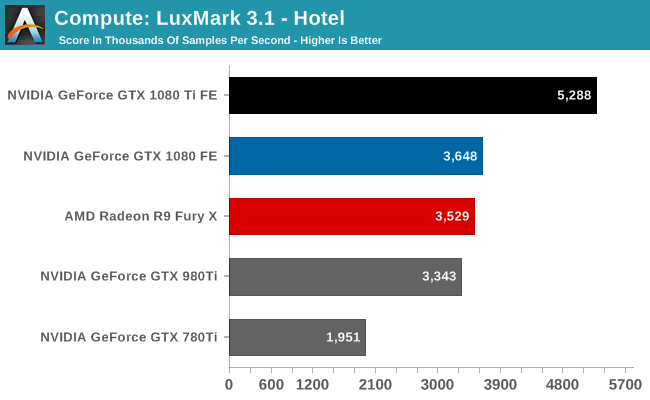
The OpenCL situation for NVIDIA right now is a bit weird. The company is in the middle of rolling out OpenCL 2.0 support to their video cards – something that I had actually given up hope on until it happened – and as a result their OpenCL drivers are in a state of flux as company continues to refine their updated driver. The end result is that OpenCL performance has dipped a bit compared to where the GTX 1080 launched at back in May, with said card dropping from 4138 points to 3648 points. Not that the GTX 1080 Ti is too fazed, mind you – it’s still king of the hill by a good degree – but the point is that once NVIDIA gets their drivers sorted out, there’s every reason to believe that NVIDIA can improve their OpenCL performance.
For our second set of compute benchmarks we have CompuBench 1.5, the successor to CLBenchmark. CompuBench offers a wide array of different practical compute workloads, and we’ve decided to focus on face detection, optical flow modeling, and particle simulations.
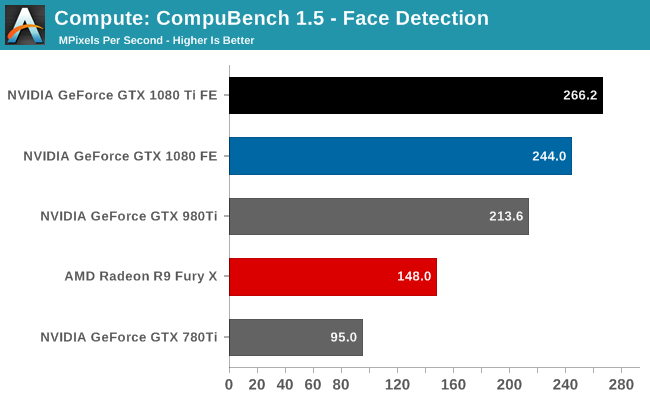
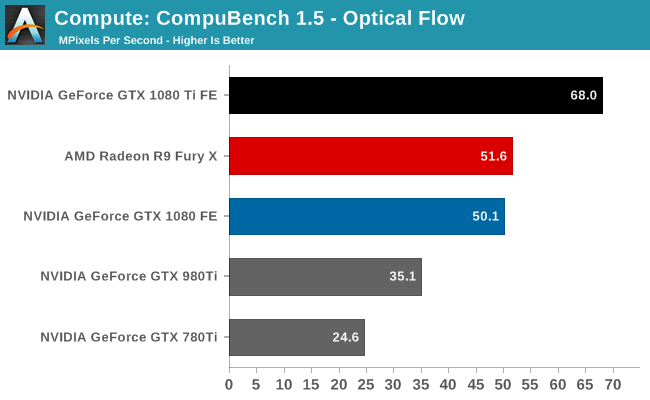
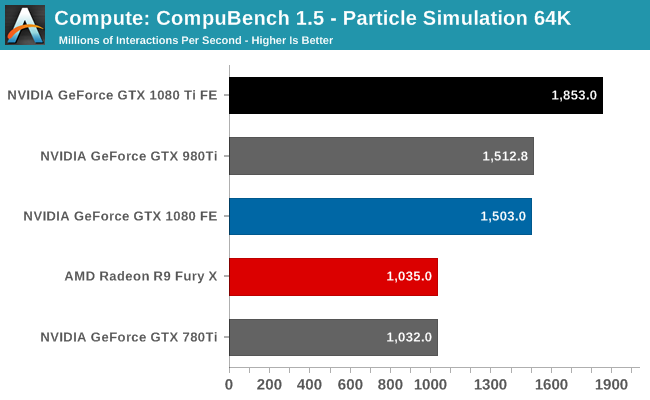
Like LuxMark, CompuBench shows some minor performance regressions on the GTX 1080 as compared to the card’s launch. None the less, this doesn’t do anything to impede the GTX 1080 Ti’s status as the fastest of the GeForce cards. It dominates every sub-benchmark, including Optical Flow, where the original GTX 1080 was unable to pull away from AMD’s last-generation Radeon R9 Fury X.
Synthetics
As always we’ll also take a quick look at synthetic performance. As a pretty straightforward and wider implementation of Pascal, GTX 1080 Ti shouldn't offer too many surprises here.
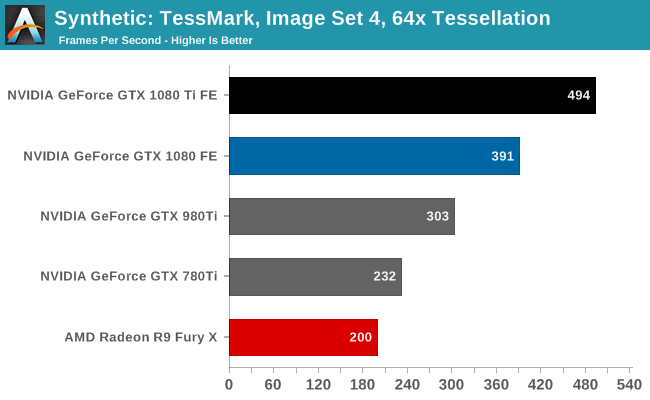
With TessMark, we find that the that the GTX 1080 Ti offers 26% better tessellation performance than the GTX 1080, and 63% better performance than the GTX 980 Ti. NVIDIA has always built their architectures geometry-heavy, and GTX 1080 Ti further adds to that lead.
Finally, for looking at texel and pixel fillrate, we have the Beyond3D Test Suite. This test offers a slew of additional tests – many of which use behind the scenes or in our earlier architectural analysis – but for now we’ll stick to simple pixel and texel fillrates.
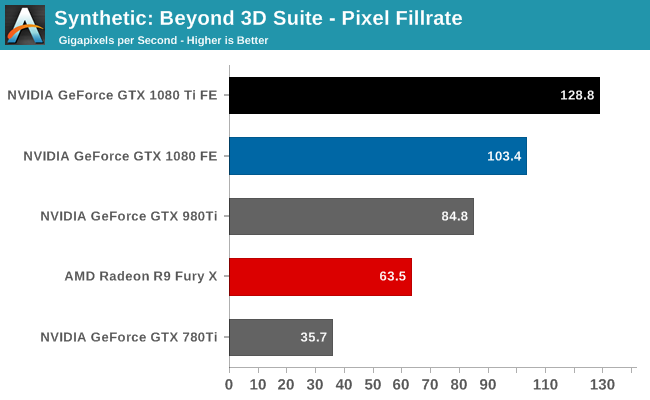
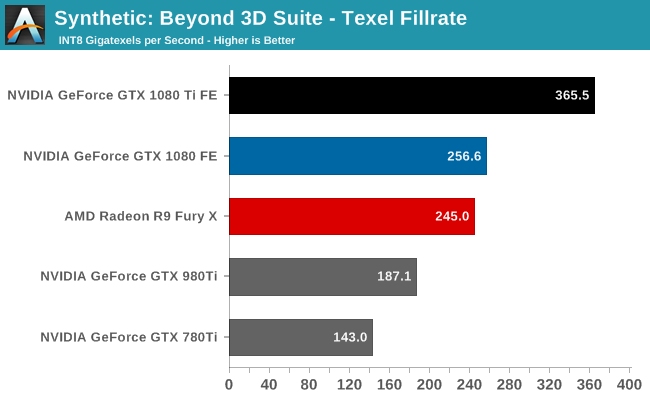
As it turns out, the pixel fillrate results for the GTX 1080 Ti are a bit surprising. The GTX 1080 Ti doesn’t dominate by as much as I would have expected given the massive memory bandwidth advantage and additional ROP throughput. Not that a 25% increase over the GTX 1080 is anything to sneeze at, but I wonder if we’re looking at one of the consequences of the unusual way NVIDIA has cut-down GP102 for GTX 1080 Ti. We haven’t seen NVIDIA disable a single ROP/memory channel at the high-end before in this manner.
As for texel fillrate, the GTX 1080 Ti excels. In fact it does a bit better than I’d otherwise expect based on the specifications. This could be a sign that GTX 1080 is a bit bandwidth limited at times when it comes to texel throughput, as that’s the facet of performance the GTX 1080 Ti has improved upon the most.
Power, Temperature, & Noise
As always, last but not least is our look at power, temperature, and noise. Next to price and performance of course, these are some of the most important aspects of a GPU, due in large part to the impact of noise. All things considered, a loud card is undesirable unless there’s a sufficiently good reason – or sufficiently good performance – to ignore the noise.
| GeForce Video Card Voltages | |||||
| GTX 1080 Ti Boost | GTX 1080 Boost | GTX 980 Ti Boost | GTX 1080 Ti Idle | ||
| 1.062v | 1.062v | 1.187v | 0.65v | ||
Starting with voltages, there aren’t any big surprises with the GTX 1080 Ti. The underlying GP102 GPU has the same load voltages as the GP104 GPU in the GTX 1080, resulting in a load voltage of 1.062v.
Moving on, let’s take a look at average clockspeeds. The GTX 1080 Ti’s official base and boost clockspeeds are lower than the GTX 1080’s, but as we’ve seen before with other NVIDIA video cards, the actual clockspeeds are a little more variable and almost always higher than NVIDIA’s official values. Consequently the GTX 1080 Ti’s clockspeeds may on average trail the GTX 1080 less than what the specifications say.
| GeForce Video Card Average Clockspeeds | |||
| Game | GTX 1080 Ti | GTX 1080 | |
| Max Boost Clock |
1898MHz
|
1898MHz
|
|
| Tomb Raider |
1620MHz
|
1721MHz
|
|
| DiRT Rally |
1721MHz
|
1771MHz
|
|
| Ashes |
1680MHz
|
1759MHz
|
|
| Battlefield 4 |
1657MHz
|
1771MHz
|
|
| Crysis 3 |
1632MHz
|
1759MHz
|
|
| The Witcher 3 |
1645MHz
|
1759MHz
|
|
| The Division |
1645MHz
|
1721MHz
|
|
| Grand Theft Auto V |
1746MHz
|
1797MHz
|
|
| Hitman |
1657MHz
|
1771MHz
|
|
On the whole, the GTX 1080 Ti does average lower clockspeeds than the GTX 1080. Whereas the latter would frequently average clockspeeds in the 1700MHz range, the GTX 1080 Ti averages clockspeeds in the 1600MHz range. This, in part, is why NVIDIA is promoting the GTX 1080 Ti as being 35% faster than the GTX 1080, despite the card having a 40% advantage in total hardware units.
It is interesting to note though that our GTX 1080 Ti sample has the same maximum boost clock as the GTX 1080: 1898MHz. If the GTX 1080 Ti didn’t hit its thermal limit as often, it likely would come even closer to the GTX 1080 in average clockspeeds.
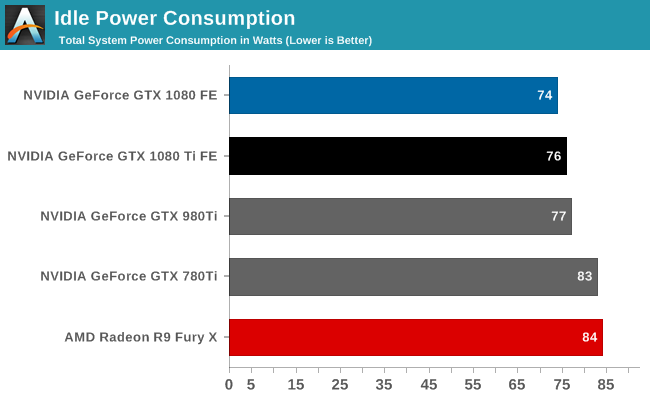
Moving on to power consumption, we’ll start as always with idle power. All told, there are no surprises here. GTX 1080 Ti’s idle power consumption is right next to GTX 980 Ti, which is where we’d expect it given the 250W design.
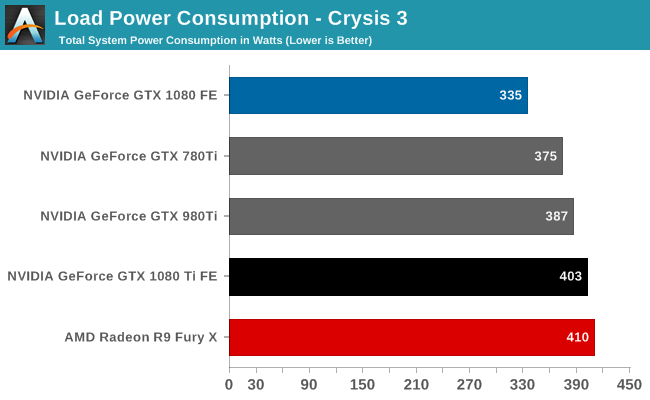
System power consumption under Crysis 3 is also right where we’d expect it to be for the GTX 1080 Ti. In absolute terms it’s second only to the R9 Fury X – which is to say that it’s high – but as Crysis 3 is a real-world test, power numbers here are influenced by the rest of the system. The faster the card, the more work required of the CPU, RAM, etc, and that’s exactly what’s happening here.
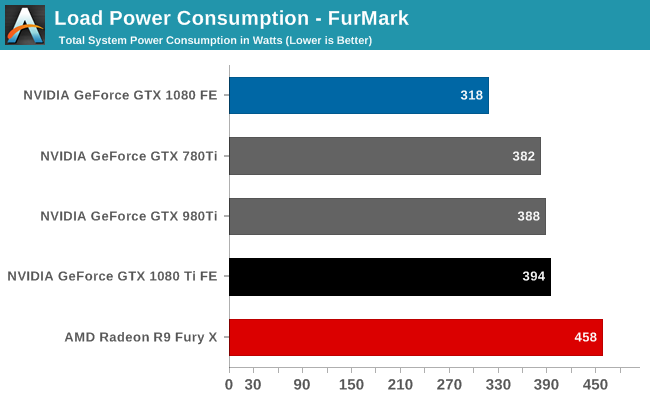
Switching over to FurMark, which is a much more GPU-focused test, we find that our GTX 1080 Ti-equipped testbed draws 394W at the wall. This is a smidge higher than the GTX 980 Ti, but not meaningfully so. All 3 250W NVIDIA cards are closely clustered together, showing that NVIDIA’s power throttling is working as expected, and at the levels expected. GTX 1080 Ti is rated for 70W higher than the GTX 1080, and our results back this rating up. With NVIDIA’s well-established power/performance tiers, GTX 1080 Ti makes the expected leap in power consumption in order to reach its loftier performance target.
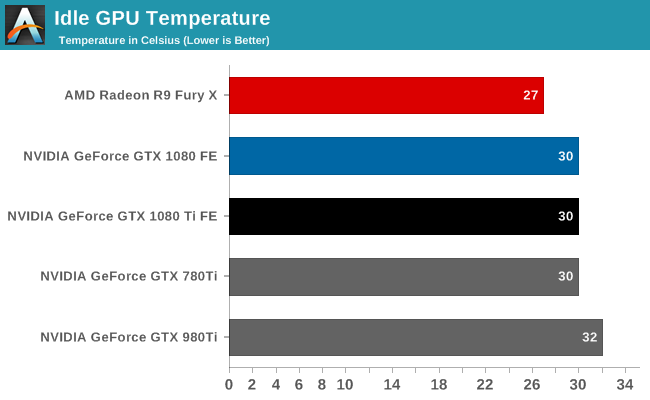
Moving on to temperatures, at idle the GTX 1080 Ti settles at 30C, the same as its siblings.
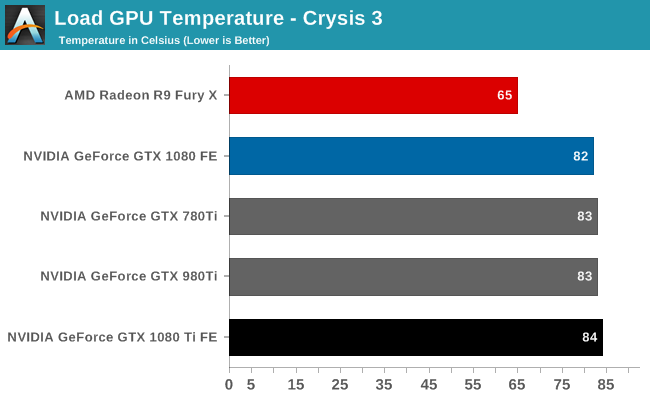
As for Crysis 3, the GTX 1080 Ti ends up being the hottest card here despite the cooling improvements, though it should be noted that this is intentional. While NVIDIA doesn’t publish this information directly, the GTX 1080 Ti’s preset thermal throttle point is 84C, which is a degree or two higher than on NVIDIA’s previous cards. As a result, the card reaches equilibrium at a slightly higher temperature than NVIDIA’s other cards.
It’s interesting to note that the throttle point has been slowly creeping up over the years; going back to the original Titan, it was only 80C. As far as reference specification designs go, the higher temperatures improve the efficiency of the cooler. The downside to higher temperatures is that power leakage increases with the temperature. So there’s a careful balancing act here in getting better cooling performance without drowning it out in more leakage-induced heat. In the case of the GTX 1080 Ti, I suspect NVIDIA paid their dues here with the additional MOSFETs, giving them a bit more headroom for leakage.
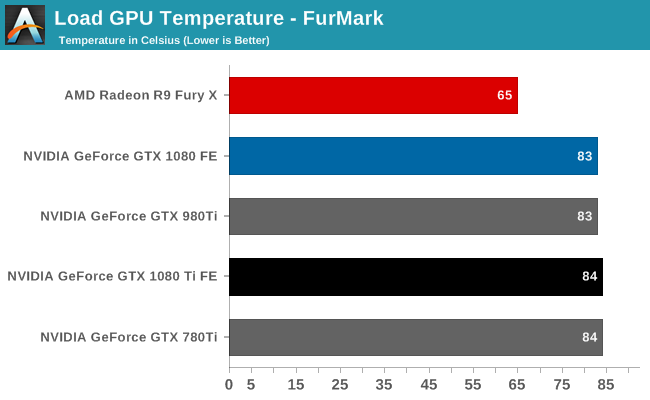
The story is much the same under FurMark. The GTX 1080 Ti settles at 84C here as well – though it did peak at 86C before reaching equilibrium – showcasing that regardless of the workload, the card always levels out at its thermal throttling point.
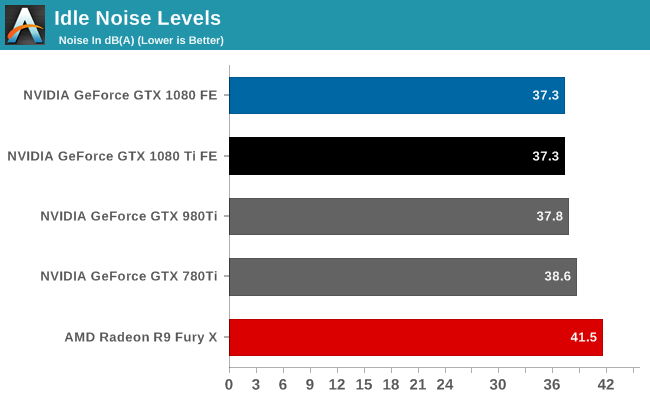
Finally we have our look at noise, starting with idle noise. Relative to the GTX 1080 NVIDIA has tweaked the fan curve a bit here, but at idle the GTX 1080 Ti is already below our noise floor.
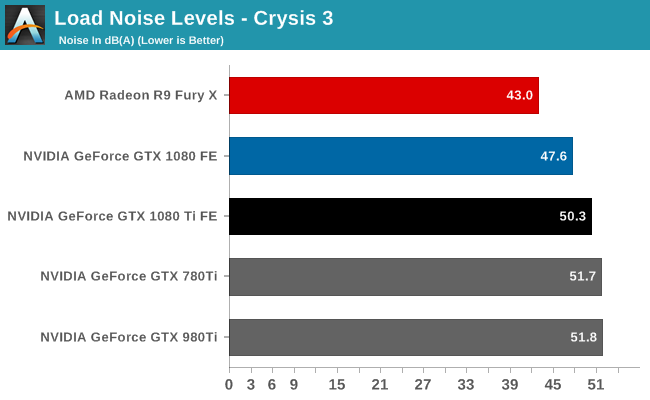
Moving over to Crysis 3, we find that the GTX 1080 Ti holds a small edge over our other 250W TI-series cards. NVIDIA’s latest card hits 50.3dB, about 1.5dB below the GTX 980 Ti and GTX 780 Ti. This won’t make much of a difference, but it does close the gap between the 250W cards and the GTX 1080 by a bit.
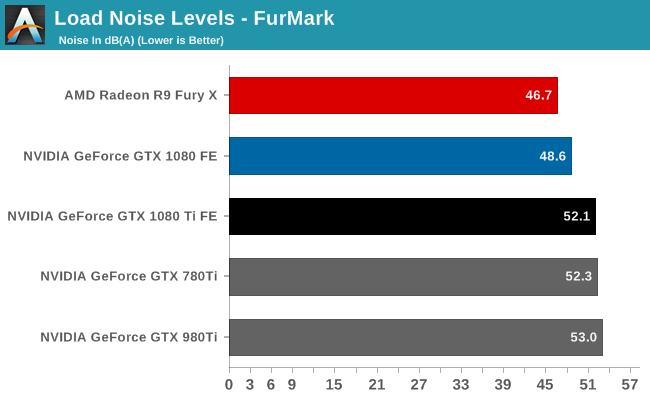
Finally, the situation with FurMark is much the same. The GTX 1080 Ti is still ever so slightly quieter than the other 250W NVIDIA cards, but a few dB louder than the GTX 1080.
Overall, judging from the power and noise characteristics of the GTX 1080 Ti, along with its throttling practices, it looks like NVIDIA invested most of their gains with the improved cooling system in removing more heat from the card itself. With few exceptions, the GTX 1080 Ti thermal throttles before it TDP throttles, and anecdotally, it tends to be closer to its TDP limit than most of the other high-end NVIDIA cards we’ve seen in the past couple of years.
Going back to what NVIDIA said earlier, they are claiming that the GTX 1080 Ti offers the largest performance uplift over its non-TI counterpart. Given that the TDP gap between the GTX 1080 Ti and GTX 1080 is actually smaller than the gap between the GTX 980 Ti and GTX 980 Ti – 70W versus 85W – if anything we’d expect this to be smaller. But by investing their gain from the improved cooler in better heat removal, NVIDIA is actually getting the GTX 1080 Ti closer to its performance/TDP limit than the previous generations of Ti cards. The only downside here is that you can only remove the DVI port once, so this isn’t an act that NVIDIA will be able to repeat in the next generation.
Final Words
Bringing this review to a close, the launch of the GeForce GTX 1080 Ti Founder’s Edition gives NVIDIA a chance to set their pace and tone for the rest of 2017. After a fantastic 2016 powered by Pascal, NVIDIA is looking to repeat that success this year. And that success starts with a very strong launch of what is NVIDIA’s new flagship GeForce card.
Because the GeForce GTX 1080 Ti Founder’s Edition isn’t NVIDIA’s first GP102-based product – even if it is their first GeForce product – I don’t think anything we’ve seen today is going to catch anyone by surprise. In fact as the third time now that they’ve released a 250 Watt Ti refresher at the high-end, I don’t think any of this should be surprising. At this point NVIDIA has their GeForce launches down to an art, and that ability to execute so well on these kinds of launches is part of the reason that 2016 was such a banner year for the company.
| GeForce GTX 1080 Ti: Average Performance Gains | |||
| Card | 4K | 1440p | |
| vs. GTX 1080 |
+32%
|
+28%
|
|
| vs. GTX 980 Ti |
+74%
|
+68%
|
|
| vs. GTX 780 Ti |
+154%
|
+154%
|
|
Taking a look at the numbers, as a mid-generation refresh of their high-end products, the GTX 1080 Ti delivers around 32% better performance than the GTX 1080 at 4K, and 28% better performance at 1440p. NVIDIA said they were going to get a 35% improvement over the GTX 1080 with the GTX 1080 Ti, and while our numbers don’t quite match that, they are close to the mark.
For GTX 980 Ti and GTX 780 Ti owners then, who are the most likely groups to be in the market for a $699 video card and looking to upgrade, the GTX 1080 Ti should prove a suitable card. Relative to the last-generation GTX 980 Ti, the GTX 1080 Ti offers 74% better performance at 4K and 68% better performance at 1440p. This is very similar to the kinds of gains we saw in the GTX 1080 over the GTX 980 last year, and in fact is a bit better than what the GTX 980 Ti did to its predecessors.
Speaking of which, it’s now been three-and-a-half years since the GTX 780 Ti launch, and GTX 1080 Ti’s performance shows it. At both 4K and 1440p, NVIDIA’s card offers just over 2.5 times the performance of their Kepler-based powerhouse. Internally, NVIDIA tends to plan for a two to four year upgrade cadence on their video cards, and 2017 is going to be the year they push remaining GTX 700 series owners to upgrade through a combination of product launches like the GTX 1080 Ti and better pricing. If you didn’t already upgrade to a Pascal card last year, then your benefit for waiting a year is 32% better performance for the same price.
Relative performance aside, in terms of absolute performance I feel like NVIDIA is finally reaching the point where they can offer no-compromises 4K gaming. While both NVIDIA and AMD pushed 4K hard on their 28nm generation of products, even parts like the GeForce GTX 980 Ti and Radeon Fury X weren’t quite fast enough for the task. 4K gaming in 2015 meant making compromises between image quality and framerates. GTX 1080 Ti on the other hand is the first card to crack 60fps at 4K in a few of our games, and it comes very close to doing so in a few others. While performance requirements for video games are always a moving target (and always moving up, at that), I think with the FinFET generation we’re finally at the point where 4K gaming is practical. And that’s in an “all the frames, all the quality” sense, not by using checkerboarding and other image scaling techniques being used by the game consoles to stretch into 4K.
Overall then, the GeForce GTX 1080 Ti is another well-executed launch by NVIDIA. The $699 card isn’t for the faint of wallet, but if you can afford to spend that much money on the hobby, then the GTX 1080 Ti is unrivaled in performance.
Finally, looking at the big picture, this launch further solidifies NVIDIA’s dominance of the high-end video card market. The GTX 1080 has gone unchallenged in the last 10 months, and with the GTX 1080 Ti NVIDIA is extending that performance lead even farther. As I mentioned towards the start of this article, the launch of the GTX 1080 Ti is both a chance for NVIDIA to take a victory lap for 2016 and to set the stage for the rest of the year. For now it puts them that much farther ahead of AMD and gives them a chance to start 2017 on a high note. But GTX 1080 Ti won’t go unanswered forever, and later on this year we’re going to get a chance to see where AMD’s Vega fits into the big picture. I for one am hoping for an exciting year.

